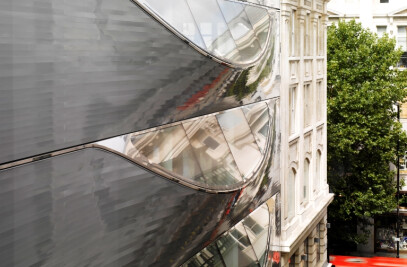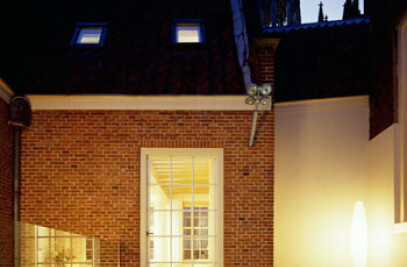In Funenpark, in the centre of Amsterdam (The Netherlands), NL Architects has designed a block of houses with an undulating green roof. In combination with a passage which crosses the block diagonally, the shape of the roof has created ten unique residences.
In the autumn of 2009, ten years after designing commenced for Block K In Amsterdam’s Funenpark, the construction of the residential building was completed. It took 7 years and a financial boom before the developer gathered the nerve to construct the complex design. “It occurs regularly that a design is continued at a later date,” according to Mr Kamiel Klaasse, a partner at NL Architects. “The design is lavish as it was created during an economic bubble.” According to Mr Klaasse, this also explains the quality of the buildings from the Dutch Golden Age.
The urban plan for this area, designed by Frits van Dongen from Architekten Cie., included a block of ten residences with roof gardens and an average of two and a half floors. NL Architects proposed to create an elevated park with two rows of five residences underneath. In order to allow the central corridor to function as a shortcut for the area, it bisects the building diagonally. As the volume of every residence is equal, the direction of the passage changes the form of the basic volume. While the footprint of some residences is indented, thereby forcing these residences to rise up, others are stretched horizontally and have become longer than average.
In order to achieve the required average of two and a half floors, NL Architects’ preliminary design featured an undulating green roof, causing the height to range from one and a half to four floors. Mr Klaasse says: “We wanted to create differentiation in the residences and make an urban statement at the same time.” When the block was redesigned in 2006, it was adapted to the latest Dutch Buildings Decree: the height of the lowest residences was raised to two floors.
The undulating green roof has several functions. The lowered centre creates a view across the building. The high corners mark the more urban moments of the Funenpark area while the low corners create a sense of space. The entire south side of the block was lowered and the north side raised to allow optimal insulation. The sum of the whole is a residential building with individually designed residences.
Mr Klaase explains the minimalist exterior: “When you work with shape, you can be more modest in the use of materials”. The largely closed end elevations are clad in champagne-coloured anodized aluminium panels. The longitudinal walls are completely transparent, which makes the block far more open than any other block in the Funenpark area.
Mr Klaasse sees this transparency as a real plus. “It is typically Dutch to have everything out in the open.” On all floors, including the ground floor, the glass façade is fitted with sliding doors. On the ground floor, these sliding doors open onto wooden decking. On all other floors, they have been fitted with a glass parapet. The terraces are quite similar to those of other blocks in the area. “As a result, the residents of this area get the opportunity to spend more time outside than anyone else in Amsterdam,” Mr Klaasse states.
The passage that provides access to the residences is less than 2m wide. For now, it is open, and Mr Klaasses hopes it will remain that way. However, the passage has some drawbacks. As the entrances to the residences and the storerooms disappear seamlessly into the lath of the façade, it is difficult to locate the residences. The building gives a sense of anonymity. This sense is reinforced by the fact that – apart from a few bathrooms – none of the rooms overlook the passage. As a result, any form of social control is impossible.
All residences have either a patio or a roof terrace or both. In Mr Klaasse’s opinion, the residences without partition-walls, where the patio provides an extra light source, are the most attractive ones. But, as he likes to stress, all residences are unique and each residence has its own qualities.
The curved roof creates a spatial showpiece on the top floors: the ceilings are concave, convex, or alternate between the two. In order to allow for the undulating roof, the height of the top floor is considerable. As a result, some of the residents have decided to move their living room up to the top floor. As the ground floor has the added benefit of a wide terrace, every residence creates a similar dilemma for its inhabitants.
The free form of the roof also has its disadvantages, as Mr Klaasse experienced when NL Architects designed a residence in South Korea. The sloping roof leads to diagonally cut windows, which make it difficult to hang your curtains. “It is like a cave: you need to learn how to live in it,” says Mr Klaasse.
Just over half the residents look out on the green roof from their roof terrace. It is a green valley which is intended to be viewed only, as the moss-sedum roof is not accessible. In future, it may be an option to heighten the roof substrate so that residents can grow vegetables on the roof. The residents of the - much higher - surrounding buildings share the view of the roof garden. “In fact, they have a better view on the green roof,” says Mr Klaasse. The entire neighbourhood profits from the building NL Architects designed.


































